
The Abernathy Kiln:
The Perfect Urban Kiln
I B Remsen, March 28, 2001
Click here to see a picture gallery of Abernathy Kilns
In the mid 1950's J T Abernathy, a studio potter in Ann Arbor Michigan, developed a radical new design for a potters kiln. It was based on the concept that you should put the burners where you need the heat energy. There are at least a dozen Abernathy kilns in the Ann Arbor area. For this report we will present data on three; the largest kiln at the Ann Arbor Potters Guild built around 1956, The Remsen Studio Kiln built in 1971, and the Ann Arbor Art Center's Art factory kiln built in 1999. They are all very similar in design, a square or 4 x 5 ratio rectangular floor area with a wall as tall as the longest dimension of the floor and a sprung arch. The ware stack is centered on this floor and fills all the space between the back wall and the door but there is a gap of 6" to 9" between the stack and the two side walls. This gap is continuous from the floor of the kiln to arch.
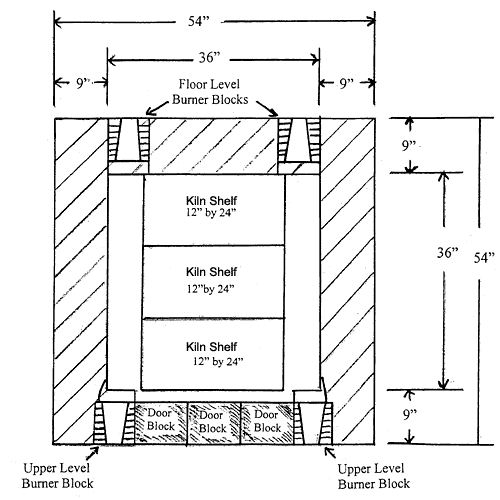
On each side of the ware stack there are two forced air burners across from each other with flame running parallel to the stack. (four burners in all) These burners are on opposite sides but a different levels. One is at the floor level and the other is just above the midpoint between the floor and the arch. All of these burners are run from one large blower. This blower is a high- speed radial type blower capable of delivering 800 CFM with pressure. The blower air comes into a chamber were it is mixed with gas and this mixture is piped to the four burner ports which are fitted with cast iron nozzles. The kiln also has atmospheric pilots and possibly small atmospheric warm-up burners.
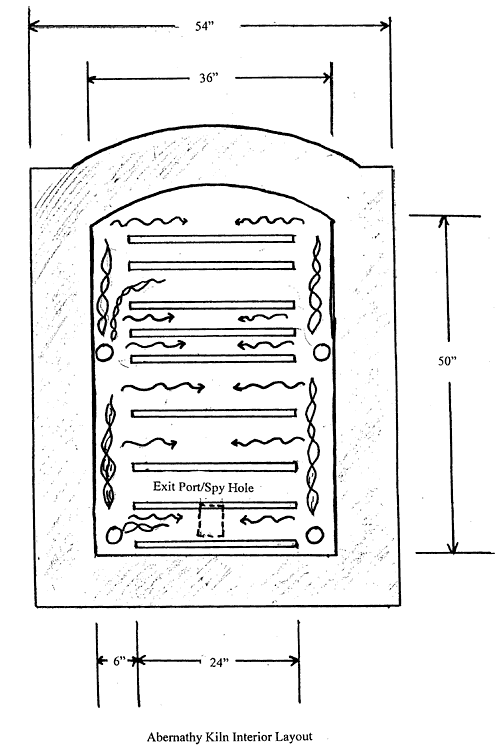
Whether they are updraft or downdraft, conventional kilns rely on a passive convection system as the main mechanism for distributing heat. The Abernathy Kiln could be called a push draft/radiation system. It has no chimney. It relies on pressure from the burner system to push heated gasses into the kiln as well as radiation from the walls next to the burners to distribute the heat towards the center of the kiln. The only exit for the heated gasses is a small view port in the bottom of the door (for a 44 cu. ft. kiln this opening might be 2.5" by 4.5"). The kiln is lightly pressurized at all times while the main burners are on.
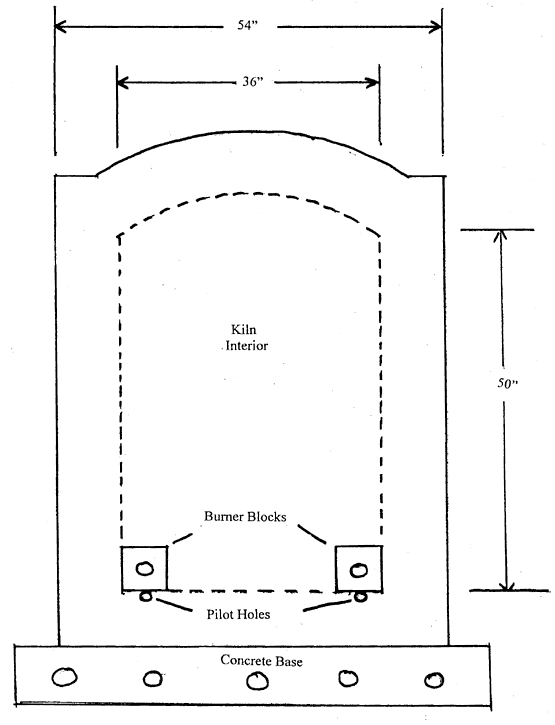
Rear Elevation
The beauty of this design is that it opens up two opportunities. First the elimination of the chimney, and Second, rapid firing for larger kilns. Olson and Rhodes both estimate that somewhere between 30% and 40% of the heat energy put into a conventional kiln goes right up the chimney. Without a chimney more of the energy put into a kiln goes towards heating the ware. Not having a chimney allows for more flexibility in kiln location.
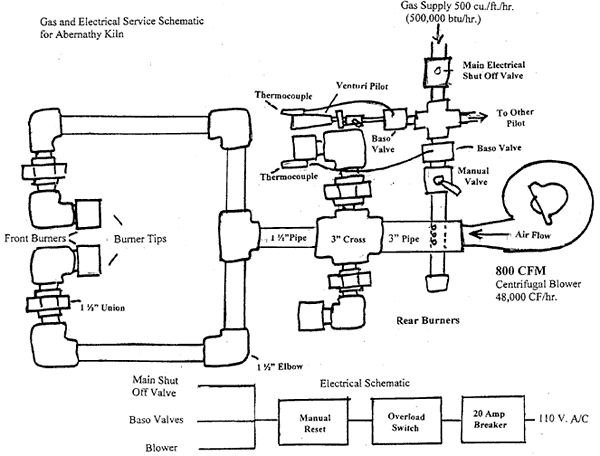
Heat loss is an increasing factor over time while the kiln is firing. The longer it takes to fire a kiln the more heat is lost, the less efficient the firing. However, fast firing of conventional kilns usually results in uneven temperatures. The passive system of heat distribution leaves cool spots that will not "catch up" without prolonged "soaking". Once the main burners are on the Abernathy kiln fires very evenly throughout and can be fired very quickly.
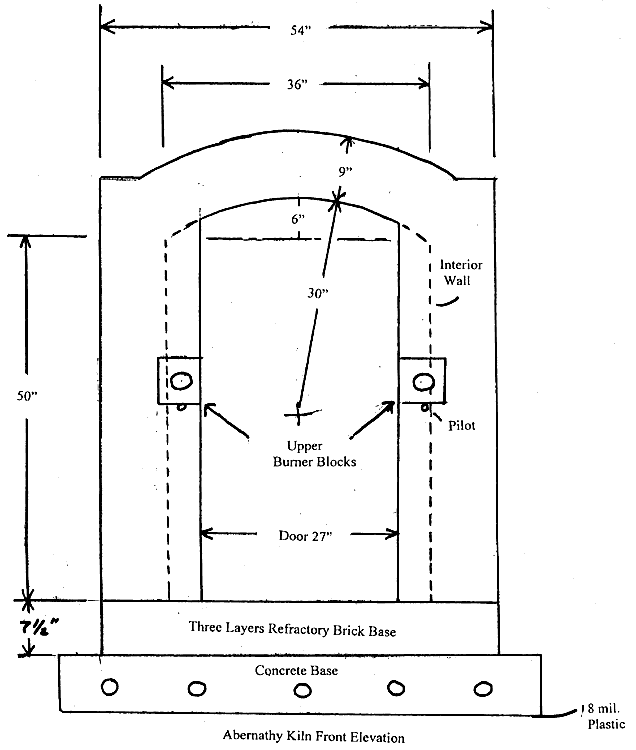
Firing Data:
All of the Abernathy Kilns in this survey were constructed with 9" of insulating brick. They were all fired with natural gas, which is figured to have 1000 Btu/Cf. The method of firing is to pilot overnight and bring the kiln to roughly 800 degrees before turning on the main burners.
First we will look at two kilns that are fired to cone 10. The large Potters' Guild kiln and the Remsen kiln. For our base line comparison we will use data from Ward Burner Systems and Data Sheets:
| Construction: 9" Insulating Brick | ||
| Cone 06 | Cone 6 | Cone 10 |
| 6,000-10,000 BTU/Cf/Hr |
8,000-13,000 BTU/Cf/Hr |
10,000-16,000 BTU/Cf/Hr |
Click here for more firing details
Ward burner estimates that at 16,000 BTU/Cf/Hr a kiln with 9" of insulating firebrick would fire to cone 10 in about 6-7 hours. This would mean a total consumption of between 96,000 and 112,000 BTU per cubic foot to fire a kiln to cone 10. We can assume that a slower firing would result in higher overall consumption. So this rate of consumption is the most efficient for a conventional kiln.
Firing Data, Large Potters' Guild Kiln:
Size: Floor 66" x 48" Height to 2/3 of sprung arch = 53"
Total 167,904 square inches or 97 square feet
This kiln was built around 1955. It is located in a large cinderblock room with two large exhaust fans. Repeated firings of this kiln show that it consumes 8,400 cubic feet of natural gas in a cone 10 firing which normally takes 12 hours. These firings involve body reduction as well as glaze reduction producing the traditional copper reds, iron greens and yellows. This is roughly 8,400,000 BTU's, or 700,000 BTU's per hour. Ward's table indicates that a conventional kiln of this size would consume between 9,312,000 and 10,864,000 BTU's if it could be fired in a more efficient time of only 6-7 hours.
So the Potters' Guild kiln seems to be firing 10 to 20% more efficiently than an optimum firing of a conventional kiln. But the real efficiency of this kiln can be seen when you look at the BTU per cubic foot per hour consumption. Dividing 700,000 BTU's per hour by 97 cu. ft. results in 7,216 BTU/Cf/Hr. Looking at the table we see that this is 30% less than the suggested minimum figure for a cone 10 firing in a conventional kiln. This seems to indicate that faster firing might produce greater efficiencies.
Firing Data: Remsen Kiln:
Size: Floor 36" x 36", Height to 2/3 of sprung arch= 56"
Total 72,576 square inches or 42 square feet
This kiln was built in 1970. It is located in a small wooden garage near the front door. Over the door there is a large exhaust fan operating at 2,500 CFM. Repeated firings of this Kiln show that it consumes 2,800 cubic feet of natural gas in a cone 10 firing, or 2,800,000 BTU, which normally take 6 _ hours. This is a reduction firing from cone 01 up. A conventional kiln would require 16,000 BTU/Cf/Hr to fire in this time and would need 672,000 BTU's per hour or 4,368,000 total BTU's to complete the firing. The Remsen Kiln uses 430,769 BTU's per hour to achieve the same effect, a savings of roughly 30%. Looking at this in another way we can refer back to the chart and see that this kiln fires as quickly as a conventional kiln of the same volume but with only 2/3 of the gas normally required for a fast firing. (10,256 verses 16,000 BTU/Cf/Hr)
Firing Data, Art Factory Kiln:
This kiln is the newest of the Abernathy kilns in Ann Arbor. It was built as a workshop project in 1999 for a total cost of around $6,000, including the furniture. It is an exact copy of the Remsen Kiln with some minor modifications. It has been fired 6 times to cone 6 using about 2,500 cu ft of gas in about 6 hours. All firings used heavy reduction. Data from this kiln is difficult to evaluate for a number of reasons.
First, the kiln is located outside in an exposed location and has only been fired in the winter months. Second, this kiln has a solid cast block door, not an insulating one. Still, it is in the low range of 9,469BTU/Cf/Hr, (Compared to Ward's 8,000-13,000 estimates). Ward's estimate for total consumption of a 42 cu. ft. conventional kiln fired to cone 6 in 6 hours is 3,276,000 BTU's. Comparing this to the figures for Art Factory kiln shows only a 24% reduction in gas consumption. Improvements in the door's insulation, the warmer summer weather, and perhaps a wind baffle should improve its efficiency.
Conclusions:
Although the Abernathy design is roughly 50 years old it is perfectly adaptable to the needs of today's ceramic studio. This design and burner system combined with fiber insulation would result in further significant fuel economy. The elimination of the chimney creates a situation where one has absolute control over the air and fuel input. Combined with today's digital technology this control would allow for infinite flexibility and improved efficiency in firing. This burner system could be retrofitted on to any sprung arch kiln, and would probably improve its efficiency and dependability.
I B Remsen, Ann Arbor, Mi.
March 28, 2001
Links
Ordering Info Entire Site ©I. B. Remsen